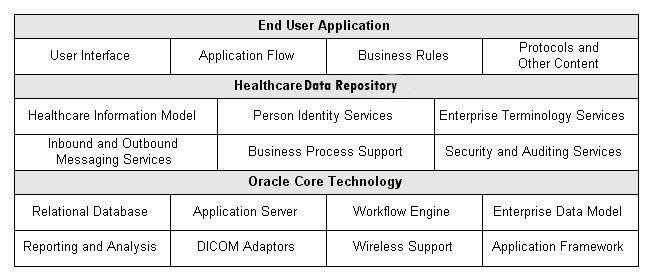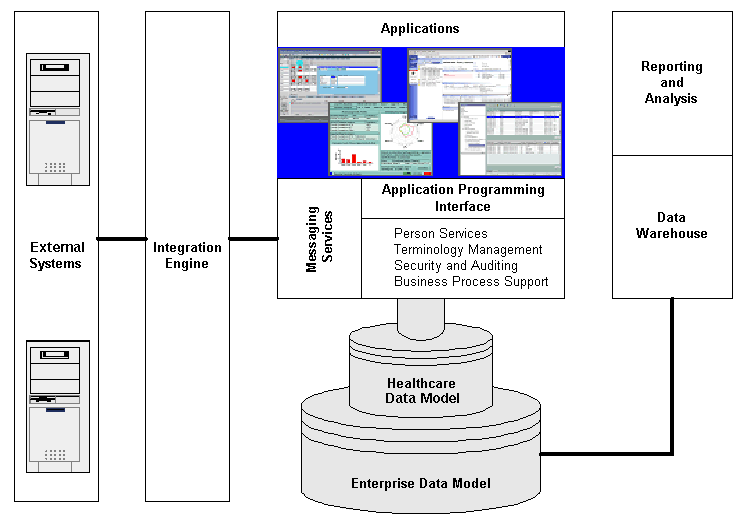1 Introduction
Introduction
Oracle Healthcare Data Repository (HDR) is a comprehensive data repository and service infrastructure that provides independent software vendors, system integrators, and provider organizations with a state of the art software platform that lets them build robust and scalable healthcare applications.
HDR software components let HDR based applications centralize and consolidate patient, provider, and healthcare data, including business rules that span the enterprise. HDR helps healthcare organizations to overcome challenges unique to their industry, and to achieve the following operational benefits:
-
Managing business transactions consistently in the patient care process, thereby increasing the efficiency, quality and competitive edge of the organization.
-
Maximizing healthcare data reuse and portability through the use of standards, enabling seamless integration and consistent implementation between variant healthcare information systems.
-
Implementing protocol-based decision support, based on a complete view of patient information.
Consistent Business Transactions
HDR provides a single definition of each business object (encounter, patients, providers, medical acts...) across the healthcare organization. This lets users create and update key patient information in a consistent manner. For example, patient encounter information can be shared by various authorized personnel across a healthcare organization-enabling the creation and maintenance of a consolidated electronic health record.
Clinical Data Reuse and Portability
In many contemporary healthcare organizations, individual departments maintain their own independent information systems. These systems typically operate autonomously and do not synchronize patient data-making it difficult to develop a consistent, integrated view of the patient.HDR provides a unified data model based on the HL7 version3 Reference Information Model (RIM), combined with sophisticated terminology mediation services incorporating standard terminologies that enable caregivers to efficiently manage and synchronize patient information. This approach lets caregivers avoid time-consuming data entry in multiple data sources while integrating patient information.
Comprehensive Community View
HDR lets multiple departments within a healthcare organization share data while maintaining a high level of autonomy. HDR provides multi-organization functionality that lets healthcare providers consistently manage and update central patient electronic healthcare records. As each department (or patient) touches a patient's specific data, the central patient record is updated accordingly. All organizations in a healthcare community can access relevant patient information (with appropriate patient consent), which translates into improved patient care, safety and reduced costs.
Overview
HDR consists of a set of services based on a foundation of selected Oracle core technologies. It includes software components that centralize and consolidate patient, provider, and clinical objects across the healthcare enterprise-providing unified access to a comprehensive healthcare infrastructure. The structure is a relational database implementation of the Reference Information Model that was developed for version 3 of the HL7 standard.
HDR Architecture

The healthcare functional domains (administrative, clinical, and financial) and core services are exposed through a Java-based Applications Programming Interface (API). The underlying HDR business logic can be extended as required for specific application functionality.
The HDR platform supports industry standards, including HL7, HIPAA privacy regulations, and standard terminology sets such as SNOMED, CPT4, and ICD9. You can use this platform to accelerate your migration to these industry standards while focusing on development of healthcare application functionality.
Business Program Interface
HDR Business program interfaces provide access to the content of the HDR data repository. They provide a thin layer of business logic, and depend upon the core HDR services.For example, an API for ordering a drug issues a call to a security interface to verify authorization, and issues a call to an Enterprise Terminology Service interface to validate drug codes. The business domains supported by HDR include the core functionality required by a Healthcare organization, as well as management of orders and observations.The core HDR services define a common service infrastructure for the development of functional components in healthcare applications. These services are exposed through a Java program interface. The core HDR service interfaces provide the basis for the business functionality. They also support efficient development of secure and scalable applications on a normalized and secure date repository.
System Administration
HDR platform services are managed through a combination of applications and program interface services:
-
Security Manager allows System Administrators define security policy and manage security services.
-
CTB Configuration APIs allow you to manage HDR configuration services.
-
HCT Administration and Authoring APIs allow you to manage Enterprise Terminology Services.
See also:
Oracle Healthcare Data Repository Javadoc for information about interfaces supported by HDR.
Leveraging Existing Oracle Core Technologies
HDR uses Oracle core technologies, which provide high performance and scalability characteristics, and ensure seamless integration with other Oracle products that use the same technology foundation.
See also:
About Oracle Healthcare Data Repository for additional information about Oracle core technologies.
HDR Usage Model
The following chart illustrates the usage model for the HDR platform:

The HL7 version 3 Reference Information Model (RIM) provides the basis for how HDR represents healthcare data. HDR uses this model to develop a collection of application services that are exposed through a J2EE compliant application programming interface, including the following:
-
Services that help to consolidate patient data into unified records.
-
Services that align the terminologies and coding system into a single unified concept-based representation.
-
Rigorous security and auditing services.
-
Persistence services for key healthcare business processes.
Developers use this foundation to build the next generation of applications for healthcare organizations. HDR provides a unified representation for the key business objects underlying these applications. Resulting application suites thus enjoy a high degree of interoperability.
The underlying healthcare data model is embedded in a comprehensive Enterprise Data Model. This broad foundation unifies the management of all of the data used in a healthcare enterprise.
HDR also includes a powerful set of messaging services that provide interfaces to systems developed outside of the HDR architecture. These messaging services manage the exchange of data between an HDR application and other information management systems, including legacy systems. The HDR Repository can thus become a comprehensive patient record for the entire enterprise.
HDR supports a transactional view of healthcare data. This view captures the dynamics of healthcare data as it evolves during business processes and supports operational applications. It also can support basic business intelligence functionality. For example, OBIEE or other similar products can be used to build reports directly on the HDR Platform
Alternatively, a data warehouse can be built on the HDR Repository. This data warehouse can support more complicated reports and analysis. Because of the data quality services provided by HDR, the resulting decision support functionality can be based on a comprehensive view of the enterprise.
Audit
The HDR Audit Service [AuditService] is a core HDR interface that lets you log and monitor HDR activities, to monitor security policy and regulation compliance—by recording actions taken during user sessions. Such event records can help detect actual or attempted violations of policy and operation procedures.
See also:
Programmer's Guide for more information on auditing and logging.
Logging
The HDR logging system is based upon an understanding of threats, risks and server/application health/vital signs. Even when operating under normal conditions, applications need to maintain health and efficiency in a shared ecosystem and make sure that the key metrics are adhered to.
In order to maintain a stable, efficient, and self-correcting cloud environment, and maintain wellness, the infrastructure must be able to log/capture appropriate information as deemed necessary and enable the administrator to assess the situation.
HDR logs:
-
Critical activities: activities of operations and access to critical resources.
-
System events: identify underlying programs and infrastructure.
-
Who, what and when.
-
All services and modules across all tiers (i.e. Web, APIs, Persistence, etc.).
HDR logging can be configured to use either JDK Logging or Log4J Logging Framework. The user has to specify which logging framework he would want to use.
See also:
Programmer's Guide for more information on auditing and logging.